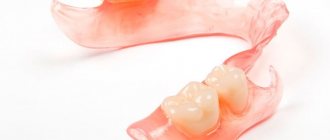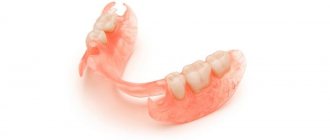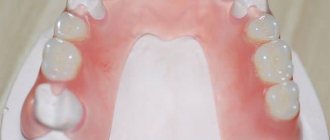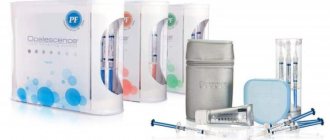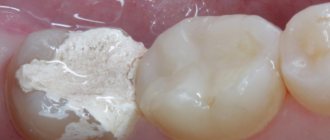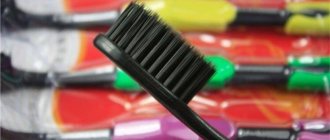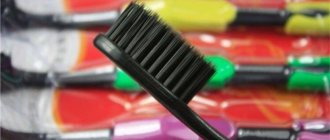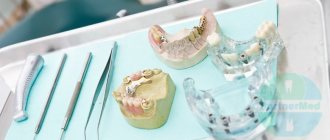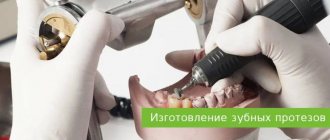1607
When a patient in a dental office is offered any type of prosthesis, the moment of choosing the material from which this structure will be made remains important.
Nowadays, clinic patients often prefer prostheses made of high-quality thermoplastic nylon. This material is used as a basis for Flexite designs.
General overview
Flexite are removable structures that have high functional and aesthetic qualities.
The main feature is the use of thermoplastic nylon . This material is highly biocompatible.
Also, its high plasticity and elasticity allows you to restore the functions of one unit or row of teeth to the maximum without discomfort.
This type of orthopedic structures is called new generation prostheses.
Flexite can produce different types:
- Microprostheses with clasps. It is this configuration that is used as an alternative to fixed structures, which are appropriate to be installed in areas with a small number of units.
Often these structures are used for adult patients who have systemic diseases, or for children who do not have molars. - Flexite partial plate dentures. If the patient has an end or included defect of varying length, then this type of prosthesis is installed.
This type of design helps to evenly distribute the load during the chewing process. Also, partial plate dentures are responsible for the stability of mobile teeth, which is important for people with gum disease.
There are quite a lot of individual types of Flexite, so the doctor can choose a system for each patient, taking into account the desires, capabilities and anatomical individuality.
The Flexite line of prostheses offers the following types:
- Plus. This option refers to universal systems because several types of material can be combined. The structures are characterized by good elasticity. Flexite plus is also endowed with low throughput against pathogenic substances.
- Supreme is a complete alternative to metal prosthetics, since the construction material is of medium rigidity. It can be used both for complete edentia and for restoring the function of a single tooth.
- Ultra - most often used for those patients who have various allergic reactions. The option with medium hardness is used for complete edentia.
- MP. This type of design is compared with Acry F acrylic systems. MPs are often installed on the entire dentition. It is characterized by high biocompatibility and repairability.
Choosing the exact type of orthopedic structure is a joint task of the doctor and the patient.
Areas of application
Flexi Nylon (thermoplastic) is used in the manufacture of orthopedic and orthodontic structures:
- Simple dentures, the base of which is made of thermoplastic.
- Combined designs where it is possible to use several types of material.
- Clasps are fasteners that securely grip the outer teeth in the gum area, allowing them to be completely invisible. In other prostheses, the clasps are made of metal, which spoils the aesthetic properties of the system.
- Some details of orthodontic systems.
Indications and contraindications
It is appropriate to install nylon systems for people with the following indications:
- In the absence of one tooth or an entire row of teeth.
- If you are allergic to metal alloys or polymers.
- In the presence of bruxism (teeth grinding).
- For periodontitis and periodontal disease.
The installation is also permissible for those persons for whom implantation is contraindicated. These include patients with epilepsy or patients with acute heart failure.
Installation of removable structures is contraindicated for people suffering from:
- Mental disorders.
- Diseases of bone tissue.
- Oncological diseases.
Before installing a prosthesis, you must warn your doctor about taking medications that may affect your blood.
When it is justified to reinforce the prosthesis and the material used.
Go here to learn more about the use of plaster in dentistry.
At this address https://www.vash-dentist.ru/protezirovanie/semnyie-p/protsedura-polirovki.html we will talk about the technique of polishing dentures.
They will work with you
Balinda Vadim Stepanovich Specialist in the field of orthopedic dentistry. Proficient in all methods of removable and fixed prosthetics, including metal-ceramic structures and the use of supports on dental implants; aesthetic restoration of teeth using metal-free structures.
Shakun Anton Yurievich Specialist in the field of orthopedic and surgical dentistry. Proficient in all modern types of dental prosthetics and surgical treatment, including: • aesthetic restoration of teeth with metal-free structures; • prosthetics with metal-ceramic structures; • prosthetics on dental implants; • dental implantation.
Chelnokov Sergey Fedorovich Implantologist, work experience in private practice for more than 26 years. Able to successfully perform implantation regardless of the amount of bone tissue available to the patient and the condition of the bone. Participant of many congresses and seminars on implantation in Belarus and abroad. He is a lecturer at the Intrnatinal Implant Foundation (International Implant Society).
Advantages
To understand the full value of the new generation of prostheses, you need to list the main advantages of the structures:
- High elasticity. Due to this property, doctors are able to reduce the load that falls on the supporting teeth.
- Small weight and dimensions. Convenient and comfortable designs allow you to speed up the process of adaptation, since the designs do not particularly interfere with talking or chewing food.
- Automatic balancing. After installation, the structure is able to independently adapt to the slightest anatomical changes in the jaw, which is convenient for the patient.
- Tight fit and minimal shrinkage can significantly extend the life of structures.
- Strength of the material. Patients now have the opportunity not to limit themselves in the choice of food products regarding hardness. The material also has excellent resistance to chemicals.
- High-quality fixation. Regardless of the chosen type of fixation, the product is securely held in the patient’s mouth.
- There is no need to grind down the supporting teeth. To fix the products, there is no need to prepare adjacent units or install additional crowns.
- Aesthetics. The product imitates the anatomical elements of the dentition, which is not only convenient, but also aesthetically pleasing. A person feels more confident and comfortable.
After installing Flexite, the patient will get used to the system within 1-2 weeks, which will speed up the full functioning of the jaws.
Removable plate dentures
Many people have seen removable dentures in their grandmothers and are traditionally associated with a glass on the nightstand by the grandmother’s bed.
The fact is that modern removable dentures look a little different, and there is no need to take them off at night. Modern plate removable dentures, in principle, have not changed over many years and are no different in appearance from the above-mentioned grandmothers. The difference is that now it is absolutely not necessary to put them in a glass at night. More modern plastics, dental sets, support-retaining cast clasps, impression materials, etc. just appeared. and so on.
The base plastic can now be not just pink, but even with added capillary vessels. The teeth come from all developed (and not so developed) countries and are so far much more beautiful than domestic sets. If you have good supporting teeth, you can cast such clasps that the denture will snap into place. At least recently, patients complain much more often that the prosthesis is very difficult to remove than that it falls out. But this is already a combination of plate dentures with support-retaining clasp clasps.
Types of removable dentures
Removable designs of laminar dentures are used in the complete absence of teeth (complete removable laminar denture), as well as in case of partial loss of teeth, if there are large defects in the dentition or there is not a sufficient number of supporting teeth for the manufacture of fixed dentures (partial removable laminar denture).
A removable lamellar prosthesis consists of a base, artificial teeth and mechanical devices (clasps, attachments, etc.) that hold or fix the prosthesis on natural teeth. The basis of a removable lamellar prosthesis is a plate made of plastic or metal. In the lower jaw prosthesis, the base is located on the alveolar processes, and in the upper jaw, in addition, it is also on the palate. Artificial teeth are attached to the base. During the process of eating, the chewing load is transmitted through the base to the prosthetic bed (tissues located under the prosthesis).
Complete removable plate dentures
Partial removable laminar dentures
Removable plate dentures are the most inexpensive, and sometimes the only possible way to replace all previously lost teeth, but they have certain disadvantages:
- disrupt taste and speech functions
- can cause atrophy of tissues under the prosthesis; in order to avoid this, it is necessary to promptly reline the prosthesis
- the material from which the base is made can cause allergic reactions (in particular, allergic stomatitis)
- the base and clasps in places adjacent to the supporting teeth can cause cervical caries and periodontal diseases with the formation of pathological periodontal pockets
Reminder for a patient who begins to use removable dentures.
All removable dentures require some getting used to. The first few days, when the irritation phase occurs, the prosthesis causes a lot of negative emotions. It's always like that. Everyone has. It all depends on your physiological characteristics of the body, but you need to survive a day or two.
Then addiction sets in. During this period, you must see a doctor to have your prosthesis adjusted. To do this, the prosthesis does not need to be removed and brought in your pocket, even if it rubs. If it is very painful, you can take it off, but be sure to put it on before visiting the doctor and chew something (even chewing gum). This is necessary so that the doctor can see the places that the prosthesis injures and carry out its correction.
Removable dentures also need hygiene. Twice a day you need to brush with a toothpaste. If you do not do this, you will soon begin to be bothered by an unpleasant odor. That's all the restrictions. With good fixation, removable dentures can be used perfectly.
Flaws
Many doctors argue that nylon prostheses are considered temporary rather than permanent.
They are not recommended to be worn for a long time, as atrophy of the alveolar process is possible. The main disadvantages of such prostheses:
- Possibility of modification of the material due to the use of too hot food;
- Possibility of gum rubbing in the area of fixation.
- Point load. The alveolar ridge of the oral cavity may atrophy.
- High price . Not all patients can afford Flexite dentures, so it is important to select designs together with your doctor, taking into account all factors.
- Difficulties in care . The material is elastic and hygroscopic, so it may not always retain its original properties after ingesting coloring food.
Before choosing any design, you need to weigh all its pros and cons, based on the advice of your doctor.
The secret of the popularity of the Ivoclar removable denture is the material used for its manufacture.
In this publication we will talk about the features of the classification of toothless jaws according to Keller.
Here https://www.vash-dentist.ru/protezirovanie/semnyie-p/perebazirovki.html all the most important things about relining a removable denture.
Features of the material
Flexi Nylon is a material consisting of high-molecular polymers of a polyamide nature, used for the manufacture of prosthetics of various designs.
Unlike acrylic systems, Flexi Nylon prosthesis does not cause allergic reactions and is not toxic to the human body.
The use of nylon in orthopedic dentistry has made it possible to achieve high functionality of systems with a relative absence of side effects for patients.
Nylon acquires its aesthetic properties by adding high-quality color pigments to it, which give the prosthesis a color identical to the natural shade.
The main component of Flexi Nylon prostheses is nylon. It provides special translucent properties, due to which the structure remains invisible in the oral cavity.
The material is processed by injection molding and is widely used as an elastic base for dentures.
How to avoid problems?
Wearing comfort, functionality and service life depend on the correct selection of design.
To avoid problems, you need to discuss all the details with your doctor. His advice and recommendations should be based not only on theory, but also on practice, so it is important to choose a qualified specialist.
When choosing a device, it is important to discuss several points:
- Type of prosthesis.
- Degree of hardness.
- Material color.
- Shrinkage percentage.
- Rules of care.
The patient must understand what design awaits him, therefore, if possible, the doctor should clearly show the selected option.
Painless
Many people have an inexplicable fear of visiting the dentist; it has been instilled in us since childhood. This is due to the fact that during the youth of our grandmothers and parents, dental treatment was carried out without the use of high-quality anesthetics. Of course, every visit to the doctor left an unpleasant impression, so they ran to the doctor only with acute pain. Today, medicine has made great strides forward; there is no longer any need to endure discomfort during treatment.
If it is necessary to perform surgery or simply remove caries, anesthesia is always used. It can be either local or general. Quite often today, complex types of pain relief are used. In this case, “freezing” the area where the doctor will work is combined with the introduction of sedatives into the body. Thanks to this combination, the person in the chair does not feel pain, he is extremely relaxed and calm, but at the same time is conscious.
If there are serious mental problems or if it is impossible to sit for a long time with your mouth open, a person may be put into medicated sleep. But when installing nylon crowns, this is not necessary, since this is the least traumatic and painful prosthetic option. A slight discomfort may appear only in the first few days, but it will completely disappear after getting used to the presence of a foreign object in the mouth.
Manufacturing
Nylon orthopedic systems for prosthetics are produced in two stages. The first is a complete examination of the oral cavity and treatment of existing pathologies. If there are teeth that cannot be treated, they need to be removed.
After treatment, you can proceed to the second stage. It includes the following points:
- Making impressions of the patient's jaw.
- Transporting the impression to the laboratory.
- Casting a model of the patient's jaw from plaster.
- Nylon is poured into the wax model, which follows the contours of the cast.
- Preliminary fitting.
- Approval of the color and shape of the resulting prosthesis.
If all the nuances have been discussed and approved, then the model is sent for final formation. Directly in the dental laboratory, specialists carry out the following activities:
- After casting the model, the boundaries of the prosthesis are applied to it with a special chemical pencil.
- These boundaries are trimmed with wax.
- The technician performs the final modeling.
- After using the thermostat, the prosthesis becomes strong, but its surface remains rough.
- The denture is polished.
Creating any type of structure has its own nuances, so it is important to fulfill all technological requirements. The work must only be carried out by a qualified specialist.
The video shows the basic manufacturing process of the Flexite prosthesis.
Price
Pricing policy depends on many factors, such as:
- the authority of the clinic;
- doctor's professionalism;
- location of the institution;
- type of design;
- condition of teeth and oral cavity;
- availability of a laboratory for the manufacture of prostheses in the institution.
If we consider installing a full nylon prosthesis, the price for such a device will range from 15,000–60,000 rubles.
Partially removable structures, which are installed when losing from 1 to 10 teeth, will cost from 10,000 to 45,000 rubles. The Butterfly microprosthesis allows you to replace no more than three teeth. Its price is 4,500–15,000 rubles.
Care instructions
To ensure that the design does not lose its aesthetic and functional properties, it is necessary to ensure proper care of the prosthesis itself and the patient’s oral cavity:
- After eating, always remove and wash the denture;
- Clean the structure with a special professional paste that will fight pigmentation;
- Rinse the system with an irrigator for disinfection 2 times in 7 days;
- Visit your dentist every 6 months for professional cleaning;
- You cannot leave the structure for a long time without a special storage liquid;
- Correction is carried out on a regular basis according to the doctor’s recommendations.
It is contraindicated to carry out correction on your own, as you can damage the prosthesis. For any changes you should visit a doctor. This is especially true for cases with chips or cracks.
Question answer
- Is it really necessary to quit smoking before implantation surgery and then not smoke for another six months? Smoking is a relative contraindication. Smoking is very harmful. If initially there are many risk factors, then we warn about this and the patient himself weighs the risk of smoking.
- Will implants interfere with general X-ray diagnostics of the body (and in particular the neck and head)?
The implants will not interfere with an X-ray examination.
Reviews
The installation of such orthopedic systems is quite common, so if you have something to share with us, we will be glad to see your feedback.
If you find an error, please select a piece of text and press Ctrl+Enter.
Tags Flexite dentures nylon dentures removable dentures
Did you like the article? stay tuned
Previous article
Review and scope of nanocomposites in dentistry
Next article
Temporary abutment is an important link in aesthetic prosthetics
